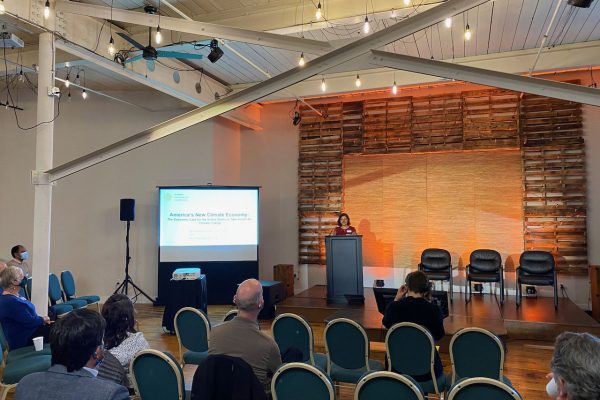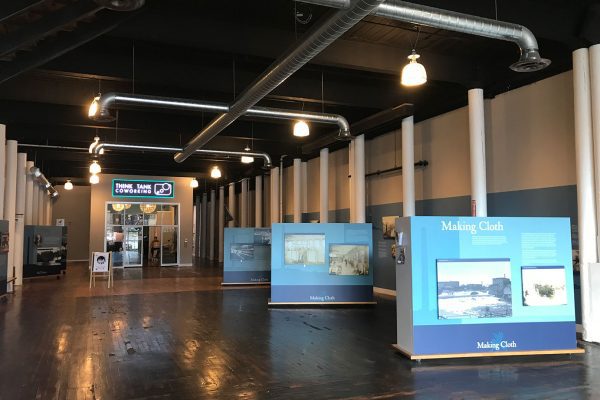Last week, in my role as Climate & Clean Energy Outreach Coordinator at the Natural Resources Council of Maine, I had the pleasure of attending GrowSmart Maine’s annual summit in the vast Pepperell Mill Campus of Biddeford. Vaulted ceilings and brick walls lit by rustic bare bulbs set the scene for a conference entitled, “Turning Climate Action into Economic Opportunity: Smart Growth Guidance for Maine Communities.”
For those of you unfamiliar with GrowSmart Maine, the small but mighty organization seeks to “build lasting prosperity without sacrificing the quality of life that defines Maine.” The focus of the summit couched GrowSmart’s mission within the broader context of climate change by highlighting ways in which our climate response can work in alignment with smart growth tenets. As we progress toward a future defined by uncertainty and change, we can seek new opportunities to sustainably grow our economy and our communities while addressing the climate crisis head on. It’s a seemingly grand vision, but one that entails localized solutions that are well within our reach.

The keynote speakers were incredibly compelling, both because they each had valuable insights to impart and because their messages were mutually compatible and reinforcing. Dr. Devashree Saha of the World Resources Institute gave an expansive view of the climate crisis, framing the issue globally and working downward toward more localized solutions that give her hope for the future. Kate Dufour, Director of State and Federal Relations for the Maine Municipal Association, followed by working from the bottom up, speaking to the ways in which local governance plays an essential role in community development and climate response. The intersection of these messages and the small group discussions that followed underscored an important theme that I’m glad to take with me into my future work.
With proper structures that incentivize participation, communities with common purpose and shared interests will come together to solve any number of problems. However, they need the resources and the information to do so. That’s where larger structures like state and national governments come in. The major federal infrastructure bill that was just signed into law will distribute $2.7 billion to Maine over the coming years to resolve infrastructure issues and build better systems, and the proposed Build Back Better Act would deliver even more if signed into law. Maine’s Climate Action Plan establishes a framework with ambitious statewide climate goals that will keep us on track to avert the worst outcomes of climate change. These larger frameworks and plans can only be accomplished through local engagement and coordination, and in turn, can only be created adequately through local participation. With these new opportunities for major societal change that have been brought about by consistent advocacy and public engagement from the grassroots up, we must now ensure that the implementation is prioritized according to need and conducted in a fashion that creates sustainable, livable, and resilient communities.
GrowSmart’s work, and this climate-oriented summit in particular, illuminate an important facet of climate advocacy that is often passed over in favor of grim projections and fear tactics: we can build a better future despite changing conditions. Change is inevitable, but it doesn’t have to happen to us. Instead, we can be agents of change and use the impetus of the climate crisis to resolve stagnant systems and address long-standing inequities. The climate crisis is upon us for many reasons, but perhaps one of the most self-evident ones is also the most useful. Our systems aren’t working. We cannot continue to travel this way, build this way, farm this way, or generate energy this way. So, we must change. And by changing, we have the opportunity to shift the current balances of power that maintain systemic inequality and support practices that are not aligned with our earth or its inhabitants.
 I think that this message has the potential to be particularly resonant in Maine. Our state has a lot of great qualities, but we have some substantial sticking points as well. We have the most rural population of any state in the nation, and we are connected by a transportation system comprised of sparse public transit options and few alternatives to personal vehicle use. Even so, over 27,000 rural homes in Maine do not have access to a vehicle, and many more split access to a single car between multiple residents. We spend more money on gas and car repairs than any other state in New England, but also have the lowest average income in the region. Our demographics are some of the oldest and whitest in the nation, and people of color in our state earn less than their white counterparts and are less likely to have access to a transportation. Further, Maine is dappled with former mill towns that have not yet rebounded from industrial collapse, resulting in systemic rural poverty and migration to urban centers out of state. To cap it all off, broadband penetration is not where it needs to be, and power outage wait times are higher than the national average, factors that have only been exacerbated by the ongoing pandemic.
I think that this message has the potential to be particularly resonant in Maine. Our state has a lot of great qualities, but we have some substantial sticking points as well. We have the most rural population of any state in the nation, and we are connected by a transportation system comprised of sparse public transit options and few alternatives to personal vehicle use. Even so, over 27,000 rural homes in Maine do not have access to a vehicle, and many more split access to a single car between multiple residents. We spend more money on gas and car repairs than any other state in New England, but also have the lowest average income in the region. Our demographics are some of the oldest and whitest in the nation, and people of color in our state earn less than their white counterparts and are less likely to have access to a transportation. Further, Maine is dappled with former mill towns that have not yet rebounded from industrial collapse, resulting in systemic rural poverty and migration to urban centers out of state. To cap it all off, broadband penetration is not where it needs to be, and power outage wait times are higher than the national average, factors that have only been exacerbated by the ongoing pandemic.
The picture I just painted may look a little bleak, but to me, these shortcomings emphasize the potential that we have to build a better state, community by community. In many places, the work is already happening. GrowSmart’s award winners were lauded for creating community gardens, establishing bikeshare programs, building accessible and sustainable housing, and developing municipal plans with an eye toward improving the standard of living for all residents.
Biddeford is a great example, which I’m sure is no coincidence. A former mill town that has long struggled with poverty and associated difficulties since the mills began shutting down in 1957 is now attracting young residents, new businesses, and new investment by repurposing old mill spaces, investing in public and active transit (biking and walking), and creating a community built around quality of life. Even in a rural state, we can actualize the features that attract economic growth and create intentional community. We can benefit from the boom of new clean energy jobs, expand broadband to ensure participation from any location, design walkable and bikeable communities that attract businesses and residents, capitalize on Maine’s abundance of renewable energy sources, invest in electric vehicles and public transit, and support local food systems. By growing smart, we can envision a future that is both climate resilient and worth living in.
—by Josh Caldwell, NRCM Climate & Clean Energy Outreach Coordinator











Leave a Reply